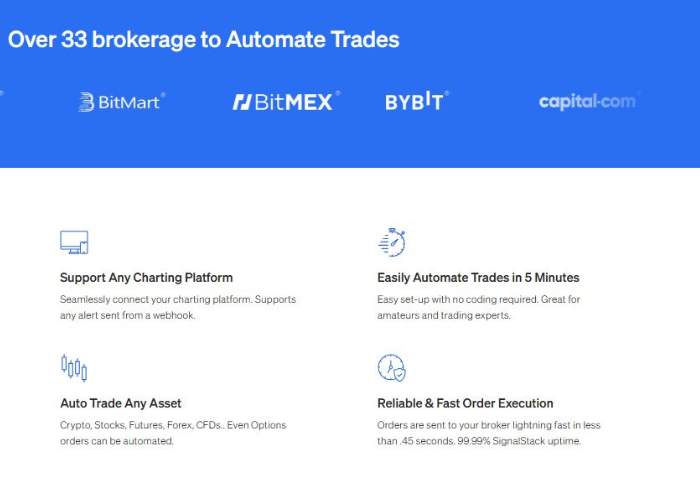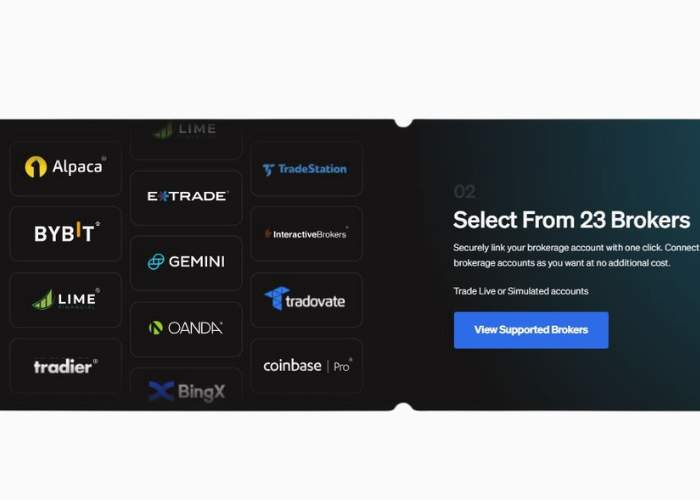Stepping into SignalStack felt like connecting a chain of trustless signals—from TradingView or TrendSpider—to live brokerage trades. No coding, just plug in webhooks. Could it actually work? Time to find out.
What Is SignalStack (and What It’s Not)?
SignalStack is a no-code trading automation platform, launched by TrendSpider in 2021. It takes alerts from your charting tools like TradingView or TrendSpider and instantly converts them into executed orders—across stocks, crypto, forex, futures, and CFDs. It connects to 30+ brokers such as Alpaca, Interactive Brokers, Coinbase, KuCoin, Capital.com, TD Ameritrade and more. Strike that: I did that setup in minutes.
Instead of building bots, you build alerts. It doesn’t think or adapt—it simply bridges signals to trades. Execution speed clocks in at ~0.45 seconds and uptime promises 99.99% reliability.(turn0search3, turn0search10) The goal: remove manual clicks and emotional hesitations, not fully replace your logic.

How My Test Went (Waves, not Linear)
I created a TradingView alert on a breakout in TSLA, hooked it to SignalStack, connected my Alpaca test account—and watched. First hit: bought at the right moment. Felt exhilarating. Then: market reversed and sold at a slight loss. Reality check.
Next, I tested closing logic: canceling a pending TP/SL bracket canceled everything—even unrelated trades. That blew my mind. I had to cancel and recreate both sides—and got charged each time. “Buy CXL/Close logic” needs doc clarity.
I also set up two alerts on same ticker across different time frames. Cue chaos—SignalStack merged both into one action. Support suggested separate accounts if you mix strategies. That felt wonky.
Overall: fast, but with risks and friction in complex setups.
Feature Breakdown
| Feature | What It Does | My Take — Caveat Included |
| Webhook Signal Integration | Trades are executed based on alerts from TradingView etc. | Lightning speed but logic merging risk needs respect |
| Broker & Asset Coverage | Stocks, crypto, forex, futures, CFDs via 30+ brokers | Wide coverage—depending on broker support vary |
| No-Code Setup | No scripting—just copy broker-specific JSON messages | Great for beginners; complex rules messy to manage |
| Signal Pricing | First 25 signals free; then $0.59–1.49 per signal | Flexible cost scaling, but pricey if volume grows |
| Logs & Alerts Monitoring | Detailed logs, webhook/test feature | Useful, though logs get chaotic if you run many alerts |
| Uptime & Speed | Tries to execute trades in under 0.45s | Execution fast—still wait on broker fill and market conditions |
Pros & Cons
Pros
- Instant conversion of alerts to trades—no code needed.
- Supports multiple asset types across many brokers—great flexibility.
- Good logging and webhook test features reduce setup uncertainty.
- Free tier with 5 signals/month—good for experimenting.
Cons / Quirks
- Bracket orders logic is confusing: one cancel wipes all.
- Multiple alerts on same symbol conflict—they don’t tag by strategy.
- Pricing per signal can escalate fast if test volume is high.
- Documentation feels thin on edge cases—support required for basic functionality.

The Emotional Curve
First trade: adrenaline. Perfect storm—not perfect strategy. Then panic when market reversed. That micro-loss stung more than it should. Next, clumsy order cancellation led to frustration—canceled bracket logic needed re-firing and cost me extra credits. Annoying.
Then a smaller win restored faith. I felt like I was swimming with a guide—not trusting blindly, but moving forward. When I tried workarounds, support helped gently. That felt reassuring: behind this tool are real people, not just code.
Pricing & What It Means for You
| Tier | Cost SignalBundle | Monthly Equivalent | Notes |
| Free | 5 signals | $0 | Useful to consider basics |
| Basic | 50 signals @ $1.49/signal | ~$74.50 | Good for small testing |
| Mid | 250 signals @ $1.09/signal | ~$272.50 | Mid-level frequency users |
| Pro | 1000 signals @ $0.89/signal | ~$890 | For heavy automated users |
No flat subscription—every signal costs. So if your strategy fires often, expect that bill. Integration with TradingView/TrendSpider required, adding extra cost.
Who’s This Platform For?
- Traders who can code alerts in TradingView and want lean automation.
- Experienced strategy users who manually monitor performance but need quick execution.
- Users comfortable scripting and managing alerts per broker logic.
Probably not ideal for:
- Beginners wanting plug-and-play set-and-forget bots
- Multi-strategy users who aim to operate many strategies on same symbol with shared account
- Users needing predictive AI decisions rather than alert execution bridging
Suggestions for Improvement
- Add signal-tagging by strategy so alerts don’t clash
- Allow cancel/modify of single bracket legs instead of wiping all
- Improved documentation on edge-case scenarios
- Bulk-discount or subscription model for heavy signal users
- UI cues when same symbol alerts may conflict
Final Thoughts (My Take)
SignalStack isn’t magic—it’s fast plumbing. It takes your TradingView or TrendSpider alerts, pushes them into your broker account, and lets them act in milliseconds. That alone is powerful. But it doesn’t think or filter—it executes.
If you’re running simple signal->trade pipelines and you’re ready to manage cancellations, know your alert logic inside out, and track signals wisely, SignalStack speeds up and simplifies trading. But if you rely on complex bracket logic or overlapping alert sets, the platform’s gaps become painful.
Start with the free signals, link a test broker, run a few live alerts, and don’t over-blast your account until you test the cancellation and order behavior. If it clicks, great. If not—you’ve learned before losing.
Need help crafting silent alerts, understanding bracket logic, or setting up tests for multiple symbol/timeframe combos? Happy to walk through real webhook payload examples and best practices.


